最近,我的朋友因为不熟悉 Vue.js 而未能通过面试。
她平时工作中大部分时间都在使用React,所以也懒得去了解其他前端框架。
世界上所有的前端框架我们都应该熟悉吗?
不,这是极其不合理的。
但为了生存,朋友还是要学习Vue的框架。
让我们看看如何使用 Vue 来实现 React 的一些功能。
1. v-if:如何显示和隐藏元素?
控制元素或组件的显示和隐藏是我们最常见的事情之一,在React中,我们经常这样编码。
JavaScript 中的三元表达式和“&”也可以实现同样的目标。
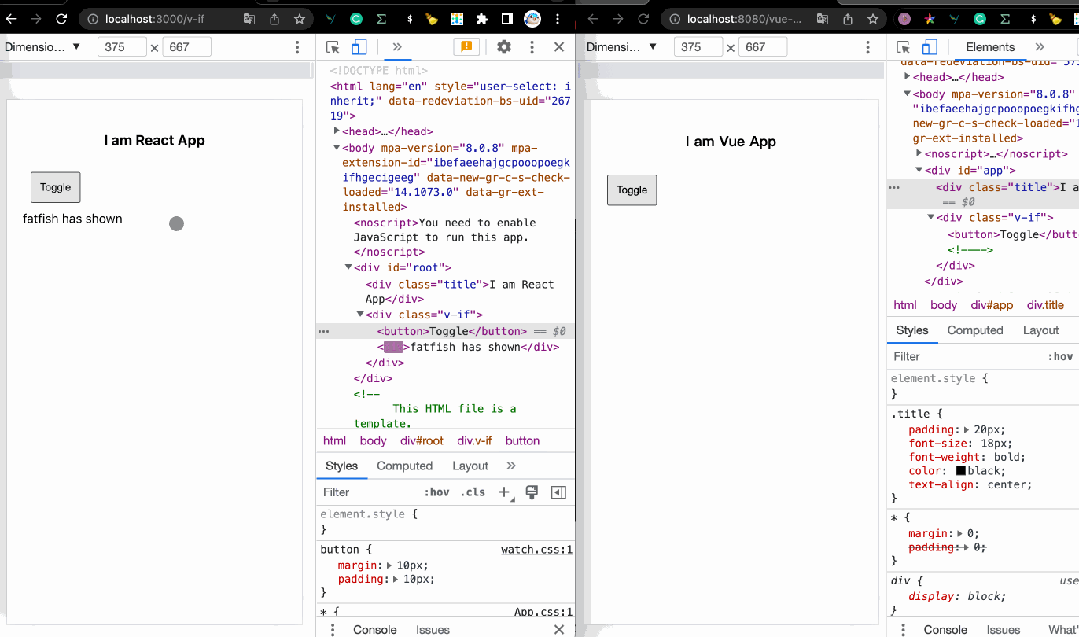
React
import React, { useState } from "react"
export default function Vif (){
const [ isShow, setIsShow ] = useState(true)
const onToggleShow = () => {
setIsShow(!isShow)
}
return (
<div className="v-if">
<button onClick={ onToggleShow }>Toggle</button>
{/* Of course you can also use ternary expressions */}
{/* isShow ? <div>fatfish has shown</div> : null */}
{
isShow && <div>fatfish has shown</div>
}
</div>
)
}Vue
那么在Vue中如何实现同样的功能呢?
是的,我们可以使用 v-if 指令来控制元素的显示和隐藏,这很简单,不是吗?
<template>
<div class="v-if">
<button @click="onToggleShow">Toggle</button>
<div v-if="isShow">fatfish has shown</div>
</div>
</template>
<script>
export default {
name: 'vif',
data () {
return {
isShow: true
}
},
methods: {
onToggleShow () {
this.isShow = !this.isShow
}
}
}
</script>2. v-show:如何显示和隐藏元素?
v-if 导致元素或组件被重复删除和创建,如果我们只想“显示”或“隐藏”它怎么办?
也许我们可以借助 CSS 中的 display 属性来做到这一点。
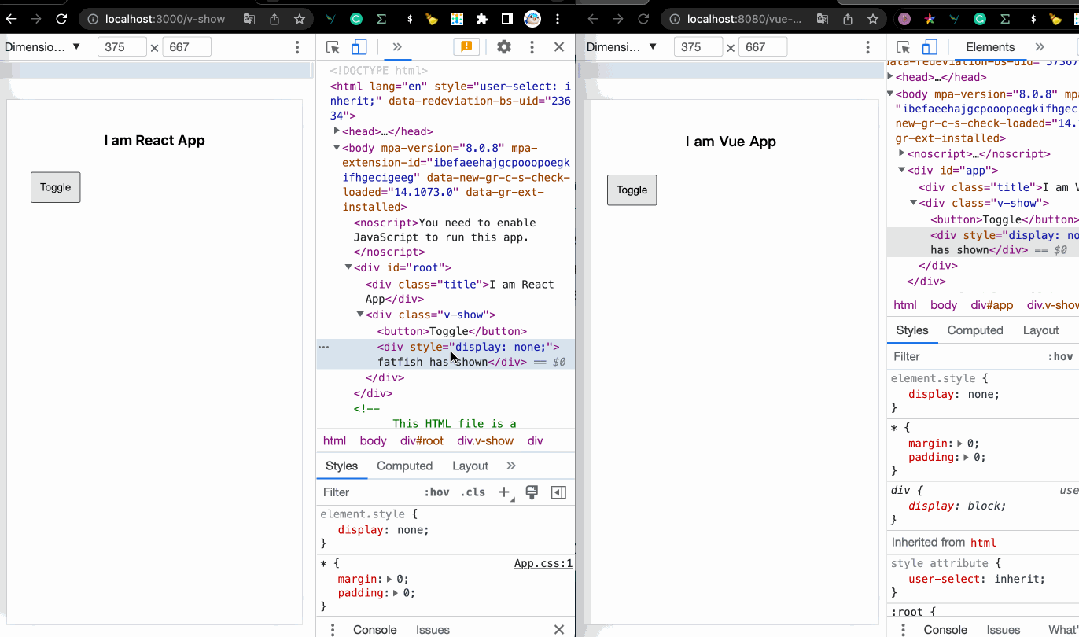
React
import React, { useState } from "react"
export default function VShow (){
const [ isShow, setIsShow ] = useState(true)
const onToggleShow = () => {
setIsShow(!isShow)
}
return (
<div className="v-show">
<button onClick={ onToggleShow }>Toggle</button>
{
<div style={{ display: isShow ? '' : 'none' }}>fatfish has shown</div>
}
</div>
)
}Vue
你可能已经猜到了,我们可以使用 v-show 来实现与它相同的功能。看起来 Vue 更简洁,你不觉得吗?
<template>
<div class="v-show">
<button @click="onToggleShow">Toggle</button>
<div v-show="isShow">fatfish has shown</div>
</div>
</template>
<script>
export default {
name: 'vshow',
data () {
return {
isShow: true
}
},
methods: {
onToggleShow () {
this.isShow = !this.isShow
}
}
}
</script>3. v-for:渲染列表?
在React中,我们可以使用数组的map方法来创建列表,这非常简单。
看一下这段代码,它创建了三个不同职业的列表。
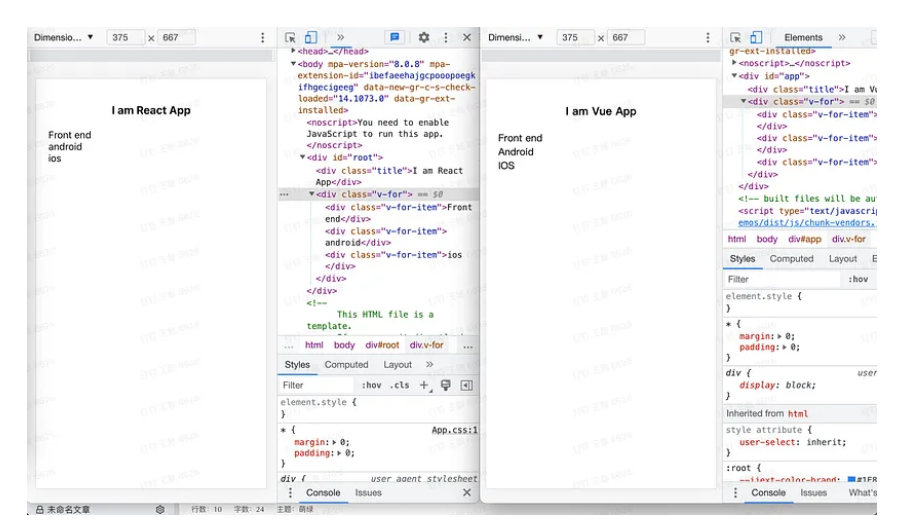
React
import React, { useState } from "react"
export default function VFor (){
const [ list, setList ] = useState([
{
id: 1,
name: 'Front end',
},
{
id: 2,
name: 'Android',
},
{
id: 3,
name: 'IOS',
},
])
return (
<div className="v-for">
{
list.map((item) => {
return <div key={ item.id } className="v-for-item">{ item.name }</div>
})
}
</div>
)
}Vue
你喜欢 Vue 中的 v-for 指令吗?
<template>
<div class="v-for">
<div class="v-for-item" v-for="item in list" :key="item.id">
{{ item.name }}
</div>
</div>
</template>
<script>
export default {
name: "vfor",
data() {
return {
list: [
{
id: 1,
name: "Front end",
},
{
id: 3,
name: "Android",
},
{
id: 4,
name: "IOS",
},
],
};
},
};
</script>4. 计算
如果我们想计算两个数的和,有什么好的方法吗?
我的意思是,当 num1 和 num2 发生变化时,它们的总和会自动变化,我们不需要手动处理。
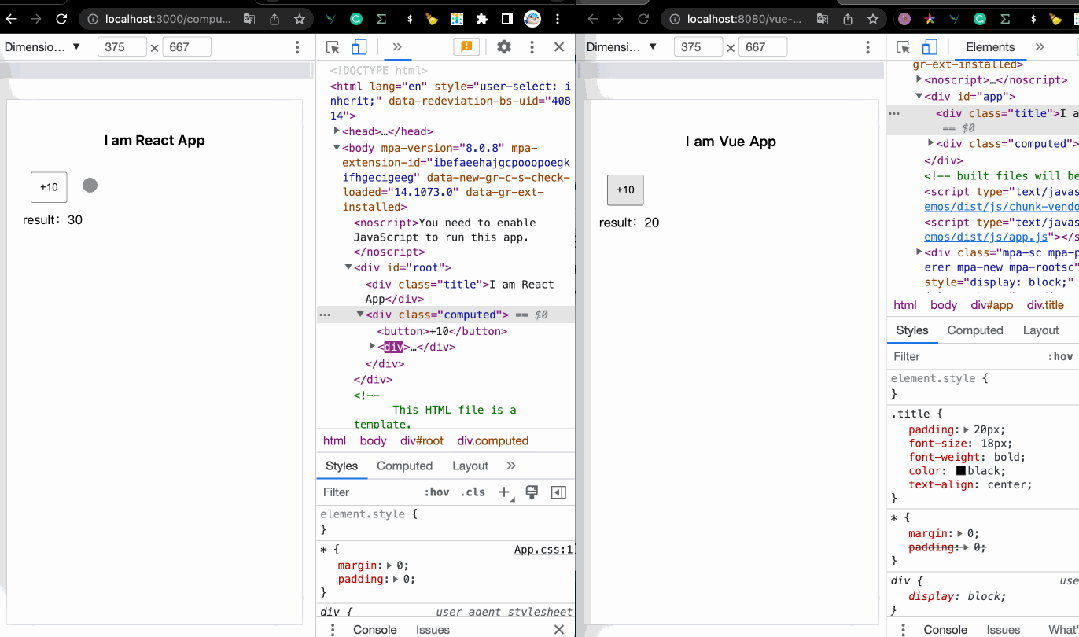
React
import React, { useMemo, useState } from "react"
export default function Computed (){
const [ num1, setNum1 ] = useState(10)
const [ num2, setNum2 ] = useState(10)
const num3 = useMemo((a, b) => {
return num1 + num2
}, [ num1, num2 ])
const onAdd = () => {
setNum1(num1 + 10)
}
return (
<div className="computed">
<button onClick={ onAdd }>+10</button>
<div>result:{ num3 }</div>
</div>
)
}哇,太棒了,useMemo 帮我们解决了一个问题。
Vue
那么,Vue中有没有更好的实现呢?它实际上提供了一种称为“计算”的机制,该机制更智能且更易于使用。
<template>
<div class="computed">
<button @click="onAdd">+10</button>
<div>result:{{ num3 }}</div>
</div>
</template>
<script>
export default {
name: 'computed',
data () {
return {
num1: 10,
num2: 10,
}
},
computed: {
num3 () {
return this.num1 + this.num2
}
},
methods: {
onAdd () {
this.num1 += 10
}
}
}
</script>5.watch
当我们需要监听数据变化然后执行回调函数时,可以在React中使用useEffect来完成。
让我们尝试模拟一个场景:
我们点击男孩或女孩按钮,选中时发送请求,最后显示请求结果(我们通过setTimeout模拟异步请求过程)。
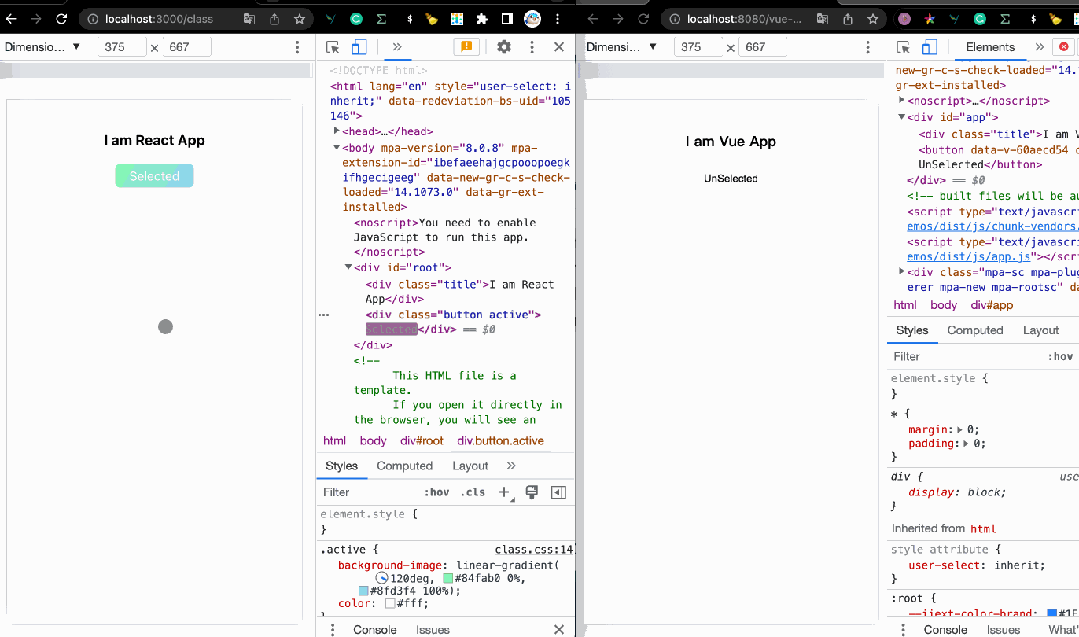
React
export default function Watch() {
const [fetching, setFetching] = useState(false)
const [selects, setSelects] = useState([
'boy',
'girl'
])
const [selectValue, setSelectValue] = useState('')
const result = useMemo(() => {
return fetching ? 'requesting...' : `the result of the request: ${selectValue || '~'}`
}, [ fetching ])
const onSelect = (value) => {
setSelectValue(value)
}
const fetch = () => {
if (!fetching) {
setFetching(true)
setTimeout(() => {
setFetching(false)
}, 1000)
}
}
// Pay attention here
useEffect(() => {
fetch()
}, [ selectValue ])
return (
<div className="watch">
<div className="selects">
{
selects.map((item, i) => {
return <button key={ i } onClick={ () => onSelect(item) }>{ item }</button>
})
}
</div>
<div className="result">
{ result }
</div>
</div>
)
}Vue
别担心,我们可以在 Vue 中做同样的事情,你知道它的秘密是什么吗?
是的,答案是watch。
<template>
<div class="watch">
<div class="selects">
<button
v-for="(item, i) in selects"
:key="i"
@click="onSelect(item)"
>
{{ item }}
</button>
</div>
<div class="result">
{{ result }}
</div>
</div>
</template>
<script>
export default {
name: 'watch',
data () {
return {
fetching: false,
selects: [
'boy',
'girl'
],
selectValue: ''
}
},
computed: {
result () {
return this.fetching ? 'requesting...' : `the result of the request: ${this.selectValue || '~'}`
}
},
// Pay attention here
watch: {
selectValue () {
this.fetch()
}
},
methods: {
onSelect (value) {
this.selectValue = value
},
fetch () {
if (!this.fetching) {
this.fetching = true
setTimeout(() => {
this.fetching = false
}, 1000)
}
}
}
}
</script>
<style>
button{
margin: 10px;
padding: 10px;
}
</style>6. style
有时我们需要动态地向元素添加样式,Vue 和 React 都为我们提供了一种便捷的使用方式。
从用途上来说,它们基本上是相似的。
相同点:
CSS 属性名称可以是驼峰命名法或短横线命名法(记住将它们用引号引起来)
差异:
- 在Vue中,我们可以通过数组语法绑定多个样式对象,React主要是单个对象的形式(这一点Vue也可以)
- 在React中,对于属性的数量,它会自动给内联样式添加“px”(这一点Vue不会自动处理)后缀,其他单位需要手动指定
- 在 React 中,样式不会自动添加前缀。当 v-bind:style 使用需要浏览器引擎前缀的 CSS 属性时,例如 Transform,Vue.js 会自动检测并添加相应的前缀。
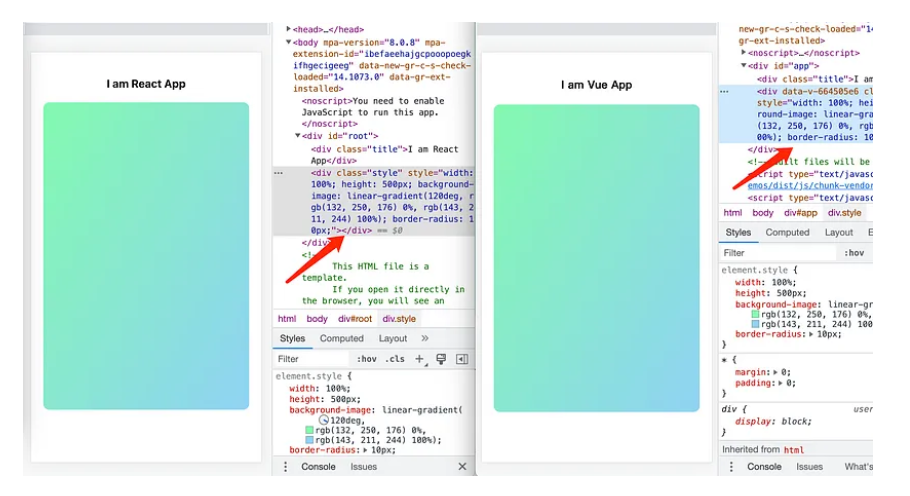
React
import React from "react"
export default function Style (){
const style = {
width: '100%',
height: '500px',
}
const style2 = {
backgroundImage: 'linear-gradient(120deg, #84fab0 0%, #8fd3f4 100%)',
borderRadius: '10px',
}
return (
<div className="style" style={ { ...style, ...style2 } } ></div>
)
}Vue
<template>
<div class="style" :style="[ style, style2 ]"></div>
</template>
<script>
export default {
name: 'style',
data () {
return {
style: {
width: '100%',
height: '500px',
},
style2: {
backgroundImage: 'linear-gradient(120deg, #84fab0 0%, #8fd3f4 100%)',
borderRadius: '10px',
}
}
}
}
</script>7.class
我们应该如何动态地为元素添加类?
在Vue中,我更喜欢使用数组语法(当然也有对象方式),在React中也可以使用一些第三方包比如classnames来起到更方便的方式来添加类的效果。
React
import React, { useMemo, useState } from "react"
import './class.css'
export default function Class (){
const [ isActive, setIsActive ] = useState(false)
const buttonText = useMemo(() => {
return isActive ? 'Selected' : 'UnSelected'
}, [ isActive ])
const buttonClass = useMemo(() => {
return [ 'button', isActive ? 'active' : '' ].join(' ')
}, [ isActive ])
const onClickActive = () => {
setIsActive(!isActive)
}
return (
<div className={ buttonClass } onClick={onClickActive}>{ buttonText }</div>
)
}Vue
<template>
<button :class="buttonClasses" @click="onClickActive">{{ buttonText }}</button>
</template>
<script>
export default {
name: 'class',
data () {
return {
isActive: false,
}
},
computed: {
buttonText () {
return this.isActive ? 'Selected' : 'UnSelected'
},
buttonClasses () {
return [ 'button', this.isActive ? 'active' : '' ]
}
},
methods: {
onClickActive () {
this.isActive = !this.isActive
}
}
}
</script>
<style scoped>
.button{
display: block;
width: 100px;
height: 30px;
line-height: 30px;
border-radius: 6px;
margin: 0 auto;
padding: 0;
border: none;
text-align: center;
background-color: #efefef;
}
.active{
background-image: linear-gradient(120deg, #84fab0 0%, #8fd3f4 100%);
color: #fff
}
</style>8. provide/inject
Vue 和 React 对于全局状态的管理都有自己很好的解决方案,比如 Vue 中的 Vuex、Redux 中的 React 和 Mobx,但是,当然,这些小项目的引入对于小用途来说有点太大了,就没有其他解决方案?
provide/inject可以在Vue中使用
React 可以使用 Context
假设我们有一个用于用户信息的全局变量“userInfo”,需要在每个组件中轻松访问它,如何在Vue和React中实现它?

React
为了在 React 中实现这一点,您可以借助 Context 将全局状态共享给任何子节点。
上下文/index.js
import { createContext } from "react";
export const UserInfoContext = createContext({
userInfo: {
name: ''
}
})App.js
import { UserInfoContext } from './context/index'
function App() {
return (
<BrowserRouter>
// Pay attention here
<UserInfoContext.Provider
value={{ userInfo: { name: 'fatfish' } }}
>
<div className="title">I am React App</div>
<Routes>
<Route path="/v-if" element={<Vif />} />
<Route path="/v-show" element={<VShow />} />
<Route path="/v-for" element={<VFor />} />
<Route path="/computed" element={<Computed />} />
<Route path="/watch" element={<Watch />} />
<Route path="/style" element={<Style />} />
<Route path="/class" element={<Class />} />
<Route path="/slot" element={<Slot />} />
<Route path="/nameSlot" element={<NameSlot />} />
<Route path="/scopeSlot" element={<ScopeSlot />} />
<Route path="/provide" element={<Provide />} />
</Routes>
</UserInfoContext.Provider>
</BrowserRouter>
);
}provide.js
import React, { useContext } from "react"
import { UserInfoContext } from '../context/index'
export default function Provide() {
// We can use the defined "UserInfoContext" through the userContext
const { userInfo } = useContext(UserInfoContext)
return (
<div class="provide-inject">{ userInfo.name }</div>
)
}Vue
在Vue中,我们可以使用“provide/inject”将顶级状态传递给任何子节点,假设我们在app.vue中声明一个“userInfo”数据。
App.vue
<template>
<div id="app">
<div class="title">I am Vue App</div>
<router-view/>
</div>
</template>
<script>
export default {
name: 'app',
// Pay attention here
provide () {
return {
userInfo: {
name: 'fatfish'
}
}
}
}
</script>provide.vue
<template>
<div class="provide-inject">{{ userInfo.name }}</div>
</template>
<script>
export default {
name: 'provideInject',
// Use data
inject: [ 'userInfo' ]
}
</script>9. Slots
假设我们要实现一个简单的对话组件,基本功能是标题可以作为字符串传递,内容部分可以完全自定义,我们应该如何实现呢?
React
虽然React中没有槽的概念,但是可以通过props.children获取组件内部的子元素,通过这个可以实现默认的槽。
Dialog.js
import React, { useState, useEffect } from "react"
import './dialog.css'
export default function Dialog(props) {
// Forgive me for implementing this in a silly way like visible -1 first, but that's not the point
const { children, title = '', visible = -1 } = props
const [visibleInner, setVisibleInner] = useState(false)
const onHide = () => {
setVisibleInner(false)
}
useEffect(() => {
setVisibleInner(visible > 0)
}, [ visible ])
return (
<div className="dialog" style={ { display: visibleInner ? 'block' : 'none' }}>
<div className="dialog-mask" notallow={ onHide }></div>
<div className="dialog-body">
{ title ? <div className="dialog-title">{ title }</div> : null }
<div className="dialog-main">
{/* Note here that the default slot function is implemented via children */}
{children}
</div>
<div className="dialog-footer">
<div className="button-cancel" notallow={ onHide }>Cancel</div>
<div className="button-confirm" notallow={ onHide }>Confirm</div>
</div >
</div >
</div >
)
}slot.js
import React, { useState, useEffect } from "react"
import Dialog from './components/dialog'
export default function Slot() {
const [visible, setVisible] = useState(-1)
const onToggleVisible = () => {
setVisible(Math.random())
}
return (
<div className="slot">
<button onClick={ onToggleVisible }>Toggle</button>
<Dialog
visible={visible}
title="default slot"
>
{/* Note that here, it will be read and replaced by the children of the Dialog component */}
<div className="slot-body">fatfish</div>
</Dialog>
</div>
)
}Vue
同样的功能在Vue中应该如何实现呢?
dialog.vue
<template>
<div class="dialog" v-show="visible">
<div class="dialog-mask" @click="onHide"></div>
<div class="dialog-body">
<div class="dialog-title" v-if="title">{{ title }}</div>
<div class="dialog-main">
<!-- Note: A default slot has been placed here -->
<slot></slot>
</div>
<div class="dialog-footer">
<div class="button-cancel" @click="onHide">Cancel</div>
<div class="button-confirm" @click="onHide">Confirm</div>
</div>
</div>
</div>
</template>
<script>
export default {
name: "dialog",
props: {
title: {
type: String,
default: "",
},
visible: {
type: Boolean,
default: false,
},
},
methods: {
onHide () {
this.$emit('update:visible', false)
}
}
};
</script>slot.vue
<template>
<div class="slot">
<button @click="onToggleVisible">切换dialog</button>
<Dialog
:visible.sync="visible"
title="default slot"
>
<!-- The <slot></slot> will be replaced here -->
<div class="slot-body">fatfish</div>
</Dialog>
</div>
</template>
<script>
import Dialog from './components/dialog.vue'
export default {
name: 'slot',
components: {
Dialog,
},
data () {
return {
visible: false
}
},
methods: {
onToggleVisible () {
this.visible = !this.visible
}
}
}写在最后
不管是开发语言,还是开发框架,都是我们实现创造产品的工具,最终,我们能够实现什么样的效果,做出什么样的产品,都是依赖实现它的人。
作为技术人,多学技术没有错,但是不能为了学习技术而学习技术,我们学习技术的目的,是要解决一些问题,这个是我对学习技术的一些感悟。
当然,也希望我今天分享的内容,对你有用。







































